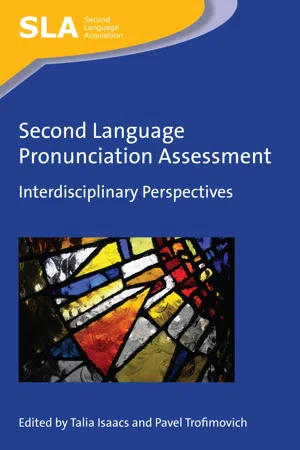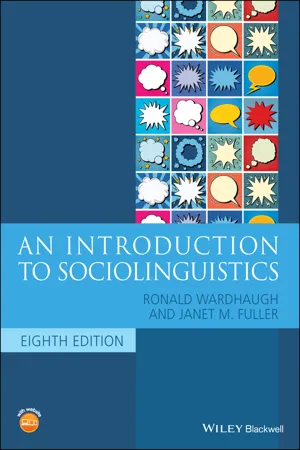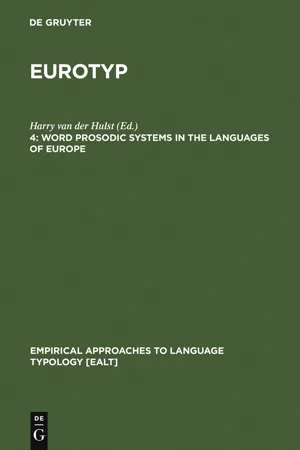Languages & Linguistics
Accent
An accent refers to the unique way in which a person pronounces words, influenced by their regional or cultural background. It is a distinctive feature of spoken language, reflecting variations in pronunciation, intonation, and rhythm. Accents can differ widely across different languages and dialects, and they play a significant role in communication and identity.
Written by Perlego with AI-assistance
Related key terms
1 of 5
12 Key excerpts on "Accent"
- eBook - PDF
Foreign Accent
The Phenomenon of Non-native Speech
- Alene Moyer(Author)
- 2013(Publication Date)
- Cambridge University Press(Publisher)
It is also the basis for intelligibility, affecting the extent to which others under- stand what we are trying to say. Accent encompasses the sounds, rhythms, and melodies of speech. Beyond mere acoustics, however, it bears much symbolic value. Simply by speaking we convey much more than literal meaning, “sometimes by design and sometimes whether we like it or not” (Brown and Levinson 1979: 300). And because everyone has a unique Accent in whichever language(s) he speaks, Accent is as relative as it is ubiquitous. The intention of this chapter is to address the scope and relevance of Accent with an emphasis on the adult second language (L2) user. To that end, we first define Accent, then briefly describe its communicative and social significance, and the special challenges of phonological acquisition beyond early childhood. 9 1.1 A definition of Accent Defining Accent is no easy task. This is partly because of its inherent variability. How we sound has much to do with where we have been, and with whom we have affiliated. It provides clues about our age, gender, regional background, level of education, and even social class. At the same time, it is a moving target of sorts, meaning that while listeners easily pick up on features that sound ‘southern,’ ‘educated,’ and so on, no two members of the same speech com- munity sound exactly alike, nor does any one person speak in acoustically identical ways across different situations, even if using the same words. When speaking with others, we continually adjust our pronunciation and alter our prosody to clarify meaning, punctuate important points, and signal distance vs. affiliation. In other words, we use Accent to position ourselves vis-à-vis others. Thus, Accent is a fluid, contextualized expression of our personal and social identity as well as our communicative stance. - eBook - ePub
English Pronunciation Models in a Globalized World
Accent, Acceptability and Hong Kong English
- Andrew Sewell(Author)
- 2016(Publication Date)
- Routledge(Publisher)
Accents, in the plural, and will critically examine accounts of so-called ‘native’ and ‘non-native’ Accents in discourses of global English. Adapting Lippi-Green’s definition slightly, in this book I will employ ‘suprasegmental’ rather than ‘prosodic’ to refer to features such as stress, intonation and rhythm. ‘Segmental’ features pertain to vowels and consonants. The term ‘paralinguistic’ will then be reserved for variables such as volume and tempo/speech rate, where necessary; some definitions of Accent (e.g. Moyer 2013) include volume.The problem with linguistic definitions of Accent based on features, however, is that they neglect the obvious fact that Accents are embodied. They can be described in linguistic terms, but they can only be performed in physical terms as part of an overall performance involving posture, articulatory settings, and other non-linguistic components. We have relatively little knowledge of the embodied dimension of Accents, and lack the terminology to deal with it adequately. Accents are in fact far more than ‘loose bundles of features’; they are ways of speaking and of being, as already noted in Chapter 1 . Although we may have to make simplifying assumptions for analytical or pedagogical purposes, teaching approaches are also handicapped if they lack a performative dimension. The linguistic characterization of Accent has significant limitations, but it is one we will have to make do with for the time being.‘Pronunciation’, on the other hand, is usually defined more narrowly as the way particular sounds or words are pronounced; it is taken by Moyer (2013) to refer to the articulation of segmental features. The problem with a very narrow definition is that, in its pedagogical or descriptive sense, ‘pronunciation’ can also refer to suprasegmentals such as word stress and intonation. This book does not attempt to make a watertight distinction between Accent and pronunciation. Accent tends to refer to more ‘global’ patterns, as in the sense of contrastable ‘regional Accents’, while pronunciation often refers to particular aspects of these patterns, as in ‘the speaker’s pronunciation of this word was unusual’. This is why the term ‘pronunciation’ is normally used in pedagogical contexts.We might, however, observe that there is an ideological aspect to the Accent/pronunciation distinction: the former implies that there is some stability and continuity, while the latter suggests that there are ‘errors’ in need of correction. Labelling becomes important, especially in global English debates. Referring to a particular ‘Accent’ normally implies that it is widely recognizable, usable by others for navigation ‘in social and geographic space’, as in Lippi-Green’s definition. In the terminology of Chapter 2 , such Accents may constitute recognizable indexical orders, ones that have been enregistered. The identification and labelling of ‘new varieties’ and their Accents, as in WE research, can therefore be seen as a contribution to enregisterment processes, an attempt to alter indexicalities. It is significant that one of the proposed criteria for the emergence of a ‘new variety’ is in fact the existence of a ‘standard and recognizable pattern of pronunciation handed down from one generation to another’ (Butler 1997: 106). In other words, WE research tends to see ‘Accent’ where others might see ‘pronunciation’. Interestingly, the Hong Kong students interviewed in this study do seem to make a useful distinction between Accent and pronunciation, and I will explore this in more detail in Chapter 6 - eBook - ePub
- John M. Levis, Alene Moyer, John M. Levis, Alene Moyer(Authors)
- 2014(Publication Date)
- De Gruyter Mouton(Publisher)
The Accent as skill perspective emphasizes the ability to form new perceptual categories. This ability is thought to be encumbered by maturational changes that are neuro-biological and/or cognitive in nature. By contrast, the Accent as identity view seeks to understand the importance of attitudes, motivation, and the extent of one’s desire to sound like a native speaker of the target language. It therefore seeks context-specific explanations for phonological attainment related to the depth and breadth of the one’s social networks, one’s attitudes regarding both L1 and L2, and even external (listener) attitudes about L2 speakers and their Accents. Both perspectives should be appreciated, because more than any other aspect of language, phonological acquisition draws on both cognitive and affective influences. Accent is both deeply internal – cognitively and psychologically – and inherently social in nature, regardless of the specific learning circumstances. This holds as true for the mother tongue(s) as it does for any subsequently learned languages (Moyer, 2013). dp n="18" folio="12" ? Pronunciation 2 in another language is not simply a matter of making oneself understood on an acoustic level. Pronunciation conveys linguistic meaning at the same time that it indicates social identity and communicative stance. This is because the way we sound overall, our Accent, is in many ways an expression of who we are, where we come from, and who we would like to be. L2 phonology 3 is an area that therefore merits investigation on many levels. The segmental level is obvious in constructs like degree of Accent, while a broader understanding of communicative, discursive fluency is front and center when we speak of suprasegmental skills - eBook - ePub
The Mysteries of Bilingualism
Unresolved Issues
- François Grosjean(Author)
- 2022(Publication Date)
- Wiley-Blackwell(Publisher)
We will then concentrate on an unresolved issue in the field: What are the main factors that account for the presence of an Accent and the variations in its strength? Maturational aspects which have been operationalized as age of onset, or age of learning the second language, immediately come to mind. Some have proposed that a language can be “Accentless” – in the sense of not being influenced by another language – if acquired before age six; others extend the window to age 12 or even 15. But things are not that clear, as we will see. We will also discuss the importance of other explanatory variables such as language input, motivation, and attitudes.We will end with a few words on having an Accent in a third language. Does it depend, for example, on the first language learned, or the second language acquired, or how much a language is used? We will see that things are much more complex than we could have thought at first.General Aspects
There exist a number of definitions of what it means to have an Accent. Baker and Prys Jones (1998) have an all-englobing definition stating that it corresponds to people’s pronunciation and intonation which may reveal, for example, which region, country, or social class they come from. Moyer (2013) concurs and writes that it is a set of dynamic segmental and suprasegmental habits that convey linguistic meaning along with social and situational affiliation. She states that defining Accent is not an easy task and that it is much more than a phonetic phenomenon. It is a reflection of our past experiences, the languages we know, our upbringing, our affiliations with various communities and social networks. As for Wrembel et al. (2018), they concentrate on a foreign Accent and write that it refers to a range of segmental and prosodic deviations from the native norms of pronunciation in a given language. In what follows, we will mainly discuss having an Accent in a second language in bilinguals – the aspect by far the most studied in the literature – but will not forget that one can have an Accent in other languages such as your first language, your third language, etc.There is a myth that real bilinguals have no Accent in their different languages, but the reality is quite different. Having an Accent in a language is the norm in bilinguals, not having one is the exception. But this does not make one any less bilingual. In fact one can be an outstanding speaker or writer of a second or third language and have an Accent. The famous author Joseph Conrad, whose English prose was superlative and required almost no editing, retained a strong Accent in English – his first language was Polish – which prevented him from lecturing publicly. - eBook - ePub
Second Language Pronunciation Assessment
Interdisciplinary Perspectives
- Talia Isaacs, Pavel Trofimovich(Authors)
- 2016(Publication Date)
- Multilingual Matters(Publisher)
The nearest approach to an explanation of good and bad language seems to be this, then, that by a cumulation of obvious superiorities, both of character and standing as well as of language, some persons are felt to be better models of conduct and speech than others. (Bloomfield, 1927: 93)The issue of Accent prestige has been much discussed with particular reference to the L1 (e.g. Wolfram, 2004). Sociolinguists researching variation, such as Mugglestone (1995), tend to view prestige as an irrelevant variable, while applied linguists such as Honey (1989) recognize that in the use of language in the community, prestige is crucial. Honey has been unfairly criticized for taking this position, which is said to be supportive of class divide. However, he is in fact pointing out just what the situation is, not that he approves of it. In other words, there is always a socially accepted prestige model of Accent.Perhaps because Accent is more resistant to change than dialect (hence foreign Accents) and more easily identified with origin and identity, there is little emphasis today on using education to change Accent. Even so, it does seem that one of the effects of education (however indirect) is to bring about some accommodation towards a norm with prestige (Davies, 2005: 4–5).Such attempts at accommodation are usually examined with regard to a non-prestige L1 Accent. But it also applies to foreign Accents. After all, just as an L1 Accent defines one’s provenance, so too does an L2 foreign Accent, which is often shared with family and peers and even larger social and regional groups. Thus, it is possible for most of us to label a speaker of English with a foreign Accent as, say, French; it is also possible for a phonologist to point to a much narrower background, say, Provencal or Normandy French. So what is Accent? David Crystal defines Accent thus:The cumulative auditory effect of those features of pronunciation which identify where a person is from, regionally or socially … the term refers to pronunciation only, it is thus distinct from dialect, which refers to grammar and vocabulary as well. … In Britain, the best example is the regionally neutral Accent associated with a public school education, and of the related professional domains, such as the Civil Service, the law courts, the Court and the BBC: hence the labels Queen’s English, BBC English, and the like. Received Pronunciation (RP) is the name given to this Accent and because of its regional neutrality, RP speakers are sometimes thought of as having no Accent. This is a misleading way of putting it, however: linguistics stresses that everyone must have an Accent, though it may not indicate regional origin. (Crystal, 1997: 2) - eBook - PDF
Pronunciation is in the Brain, not in the Mouth
A Cognitive Approach to Teaching it
- Edward Y. Odisho(Author)
- 2014(Publication Date)
- Gorgias Press(Publisher)
59 C HAPTER 4: L INGUISTIC A CCENT : D EFINITION , C LASSIFICATION AND D EMONSTRATION 4.1. I NTRODUCTORY R EMARKS As mentioned earlier on with regard to the difference between dialect and Accent, the former is usually used to refer to a com-bination of grammatical, lexical and pronunciation differences, whereas the latter is essentially confined to pronunciation dif-ferences. In fact, in ESL classroom situations or real-life interac-tions, one is able to identify the Accent of an L2 speaker not necessarily based exclusively on pronunciation inaccuracies and deviations from acceptable targeted standard pronunciation. In many instances, there are grammatical, morphological and lexi-cal hints that trigger an Accent in pronunciation. Take, for in-stance, the case of some English past tense and past participle formations of verbs which end with suffixes that are in the form of voiced or voiceless consonant clusters. Often such clusters are broken up or reduced in one way or another by Hispanic learn-ers of English because they are alien to their native phonology. For example, the past tense of is and are pronounced as ]. Traditionally, Hispanics try to overcome the problem in one of two ways both of which are, unfortunately, wrong: 1) Reduce the cluster by dropping one of its elements, usually the latter. This means that instead of pro-nouncing [ ] and [ ] correctly, they would simply reduce them to [ ] and [ ]. 2) Insert a vowel between the two el-ements of the cluster, break up the cluster and cause a reshuffle in the syllabic structure of the word. To demonstrate, instead of pronouncing the word or as [ ] and [ ], they are rendered roughly as [ ] and [ ]. Un-doubtedly, this is a grammatical problem but its roots are in pronunciation. In the totality of the performance of English, - eBook - PDF
Language and Nationality
Social Inferences, Cultural Differences, and Linguistic Misconceptions
- Pietro Bortone(Author)
- 2021(Publication Date)
- Bloomsbury Academic(Publisher)
The use of apposite jargons too, as we shall see, can affect decisively the way in which a person is assessed and categorized. Furthermore, vastly different assumptions are made about someone depending on which language he or she speaks natively – a key issue that we will discuss when we look at the title topic of this book: the links between language and nationality. Examples: vocabulary, Accent, syntax, whole languages Let us zoom in on Accents, because in England they have an exceeding social significance due to their notoriously close connection to class. While the upper-class Accent is, to a considerable degree, supra-regional and without much local inflection, the Accents of those born and raised further down on the socioeconomic scale were, and to a significant extent are, marked by regional peculiarities. It is not an accident that Accents are central to most stereotypes. The correlation between certain features Ways of Speaking 31 of British pronunciation and social class is well documented by sociolinguists, but also empirically well-known to the general public. A 1980s survey across Britain (quoted in Wells 1982: 15) asking what distinguishes upper-class people found that ‘the amount of money they have’ was only the seventh most frequent factor indicated, after what job they have, where they live, or what social circle they are in. The top answer was ‘the way they speak’! Conversely, people from the opposite end of the socioeconomic spectrum have usually been said to have an Accent that marks them as low-class or ‘common’. From all this we can see that Accent does not just signal class, but also constitutes it. Accent in Britain can then have further associations. Until some years ago, the Accent of British politicians was enough to signal to which of the two main political parties they belonged: RP meant Conservative, and regional Accents meant Labour Party. - eBook - PDF
English across Cultures. Cultures across English
A Reader in Cross-cultural Communication
- Ofelia García, Ricardo Otheguy(Authors)
- 2012(Publication Date)
- De Gruyter Mouton(Publisher)
With regard to Accent perception, much of the research done by 56 R.T. Williams social psychologists of language has up to now dealt with gauging social attitudes towards ethnic speech, and has tended to see the process of speaker categorisation through Accent as standing outside the flow of face-to-face communication. (See, however, Brown and Levinson 1979). It will be one of the aims of this paper to suggest that, contrary to this trend, research on Accent perception can be relevant to the study of cross-cultural, face-to-face communication, serving to confirm, highlight and add to our understanding of the problems that are inherent in such communication. This paper 1 examines some of the pragmatic, cognitive and social factors that are involved when a speaker is assigned (or mis-assigned) by a hearer to a particular group on the basis of Accent. The discussion will be limited to native speakers of English whose speech differs from the interlocutor's by virtue of its being a regional or national variety 2 ; for example, Lancashire English, Australian English or Singaporean English. This perspective would seem particularly useful in light of the development of English as an international language and of the increasing migration that is occurring between English-speaking countries. The results of several case studies on the perceptions of English Accents are reported in the paper. These reports are preceded by an extensive presentation of the theoretical framework on which the case studies are based. The paper is organised as follows: Section 2 will deal with the indexical nature of speech, providing a background to the process of Accent identification and speaker categorisation, which is seen to be an act of correlating various speech markers with particular cognitive categories of group membership. - eBook - PDF
- Ronald Wardhaugh, Janet M. Fuller(Authors)
- 2021(Publication Date)
- Wiley-Blackwell(Publisher)
In these contexts there are also Accents which are considered standard. As a final observation we must reiterate that it is impossible to speak English (or any other language) without an Accent. There is no such thing as ‘unAccented English.’ RP is an Accent, a social one rather than a regional one. However, we must note that there are different evaluations of the different Accents, evaluations arising from social factors not linguistic ones. Matsuda (1991, 1361) says it is really an issue of power: ‘When . . . parties are in a relationship of domination and subordination we tend to say that the dominant is normal, and the subordinate is different from normal. And so it is with Accent. . . . People in power are perceived as speaking normal, unAccented English. Any speech that is different from that constructed norm is called an Accent.’ We will return to such matters in the next chapter in our discussion of language attitudes and ideologies. Further, we will address the use of English as a lingua franca (i.e., non- native Englishes) in chapter 9. Social Dialects The term dialect can also be used to describe differences in speech associated with various social groups or classes. An immediate problem is that of defining social group (see chap- ter 3) or social class (see chapter 5). Proper weight needs to be given to the various factors that can be used to determine social position, for example, occupation, place of residence, Exploration 2.3 The Standard and Accents Drawing on this discussion of English Accents, discuss Accents of other languages you are familiar with: is there a prestigious Accent associated with a particular region or is it seen as regionally neutral? Are there different ways of speaking the Standard in dif- ferent regions? Have there been changes or developments in what is considered Standard? Give specific examples where possible. - eBook - ePub
- Martin Montgomery(Author)
- 2008(Publication Date)
- Routledge(Publisher)
It is often presumed that certain patterns of pronunciation become preferred within a speech community because they are inherently more correct, or because they are intrinsically more pleasing to listen to. Available evidence, however, points in a quite contrary direction and suggests that there is nothing in a sound itself that can guarantee a prestige status for it. Instead it is social evaluation solely that confers prestige or stigma upon certain patterns of pronunciation. For one thing the prestige form of one language area can turn out to be the stigmatized form of another. The prestige form of pronunciation in New York may well include an audible /t/ sound after a vowel in words such as ‘car’, ‘north’, ‘guard’, but in Britain the audible inclusion of this sound in this position can merely sound rustic or even comic, being primarily associated with the patterns of pronunciation of rural south-west England. For another thing, speaker’s unfamiliar with the language in question often have the greatest difficulty discriminating between one form of pronunciation and another, never mind identifying the prestige pattern. Among French speakers, for instance, Parisian French is generally held to be more prestigious than French Canadian. Non-French speakers, however, cannot even tell the difference between them, let alone display a consistent preference for one or the other. So there are no purely linguistic grounds for preferring one form of pronunciation to another. It is primarily a matter of social attitude: the speech patterns of the dominant social group come to be regarded as the norm for the whole society, though this normative pressure may often be rationalized in terms of aesthetic appeal or by reference to false notions of linguistic propriety.Accents as a Residue of Earlier Dialect DifferencesWhat we have been considering, in effect, is the Accent aspect of dialect differences, where ‘Accent’ as a term is exclusively reserved for whole patterns of pronunciation typical of a particular region or social group. The term ‘dialect’ covers a broader range of differences, including not only matters of pronunciation, but also distinctions in vocabulary and sentence structure. The extension of a language (say, English) through space and through time allows for quite fundamental differences to emerge and exist side by side within the whole, as its speaker’s move and settle, shape it to express new experiences, and it comes into contact with other languages. It will be changing continuously, but at differing rates within the sub-communities of the English speech community. Some of these changes will be instigated locally but many of them will spread out in waves from centres of power and influence, moving probably from city to city first, and then only later and more slowly encompassing the intervening rural areas. It is the varying and uneven rates of change actually ‘on the ground’, so to speak, that make dialect differences inevitable. None the less, if the hold of the centre on the periphery is strong (through, for example, uniform legal, administrative, educational and writing systems) then, despite the fact of language change, there will be strong pressures in the direction of linguistic conformity. Thus, within the British Isles many of the more fundamental differences of vocabulary and sentence structure between the English dialects have become eroded (not to mention, of course, the drastic decline – sometimes active suppression – of Welsh and Gaelic). Often, all that remains as a kind of historical residue of the original dialect is its distinctive mode of pronunciation – its Accent. For this reason, we now have a situation in which the standard dialect is spoken with many differing regional Accents. - eBook - PDF
Accent and Teacher Identity in Britain
Linguistic Favouritism and Imposed Identities
- Alex Baratta(Author)
- 2018(Publication Date)
- Bloomsbury Academic(Publisher)
If dialect speakers do not come into everyday contact with the standard form, they may not see a reason to change their language use. As has been made clear, however, while there are indeed contexts in which dialectal usage would be seen as highly appropriate (e.g. a local wedding with close family and friends), there are contexts in which its use would not be appropriate. Second, and an important point to make regarding the need to clarify ‘Accent’ and ‘dialect’, is that while Accent, strictly speaking, refers to one’s pronuncia-tion, and dialect refers to specific use of grammar and lexis, I agree, in conjunc-tion with Crystal (1996), that the two can be intertwined. For example, would speaking in, say, Geordie dialect (referring to the variety found in Newcastle, England) still be seen as authentic if the speaker did not have an accompanying Geordie Accent? If we consider the phrase (in Geordie dialect) I’m gannin’ doon the toon (I’m going downtown/to the city centre) delivered in any Accent but the one tied to Newcastle, it is very likely that the local people would not see this as authentic, or perhaps see it as somehow ‘incomplete’; if spoken in RP, it might even be perceived as insulting. Or, it could of course be an example of retaining one’s natural Accent to otherwise speak in a ‘foreign’ dialect as a means to gen-erate humour. However, Crystal’s (1996) claim that speakers of regional dialects use regional Accents simultaneously suggests that we might consider regional pronunciation to be a part of the regional use of grammar and vocabulary also. Accents in Britain and Linguistic Prejudice 59 Thus, while the focus within my book is solely tied to Accent (i.e. pronunciation), I nonetheless suggest that for regional dialects to be considered ‘complete’, we need to incorporate the accompanying regional Accent as well as regional gram-matical forms and lexis. - Harry van der Hulst(Author)
- 2008(Publication Date)
- De Gruyter Mouton(Publisher)
4 Harry van der Hülst tone, and, more generally, the typology of word-prosodie systems including both stress- and pitch-Accent systems. The phenomena that are studied in this volume are rich and varied and this has inevitably led to a proliferation of terms. In this introductory chapter, I will use my own terminology as consistently as I can. Such consistency, however, is not maintained throughout the whole volume. In § 1.6 I will therefore also discuss a number of terminological issues, as well as matters involving phonetic and phonemic transcription. 1.2. Basic concepts 1.2.1. Accent In dictionary entries lexicographers often use a graphic symbol, adjacent to or on top of one of the letters, to indicate what is called the location of Accent or stress; henceforth, I will use the term Accent(ed) and return to termino-logical issues in § 1.6. If a phonetic transcription is added to the spelling form, the Accent symbol is often a small superscripted vertical line which is placed before the syllable that is Accented. This practice is illustrated with a few ran-dom examples from an English dictionary: (1) escalade [esks'leid] ... escalate ['eskaleit] ... escallop [is'kobp] ... The symbol in question is meant to provide information regarding the correct pronunciation of the entries. In the example at hand, the idea is that the syllable following the symbol is pronounced in a manner that makes it perceptually more salient than the other syllables. For the moment let us simply assume that salience is achieved by enhancing or modulating those properties that all sounds have, i. e., duration, intensity, pitch, and manner of articulation. Right from the start, I would like to make a sharp conceptual distinction between the notion Accent, here conceived of as an abstract property of a unit such as the word, and the phonetic cues (or phonetic exponents) that signal the Accent to the listener. Accentual marks do not provide information about the phonetic cues.
Index pages curate the most relevant extracts from our library of academic textbooks. They’ve been created using an in-house natural language model (NLM), each adding context and meaning to key research topics.











